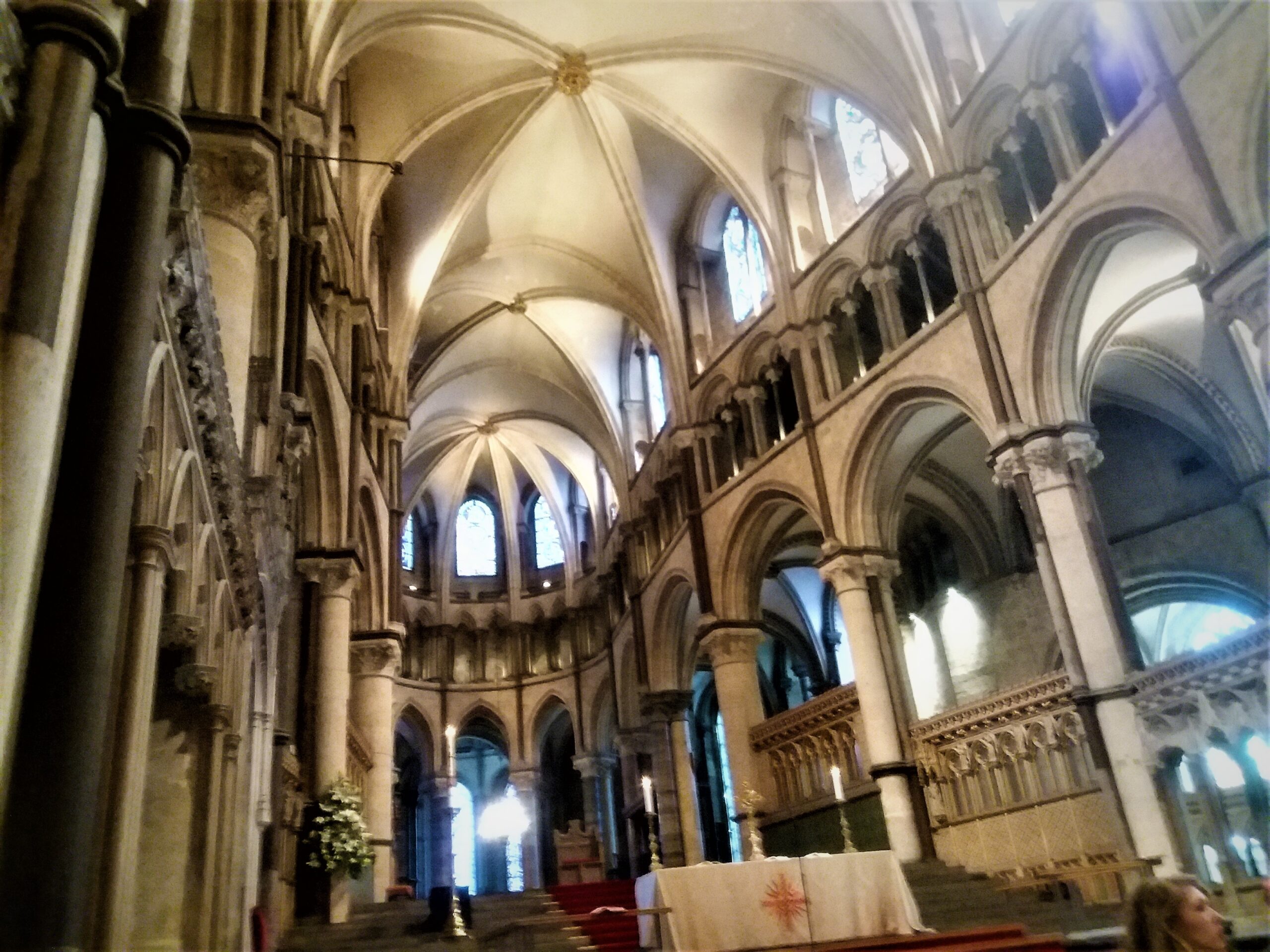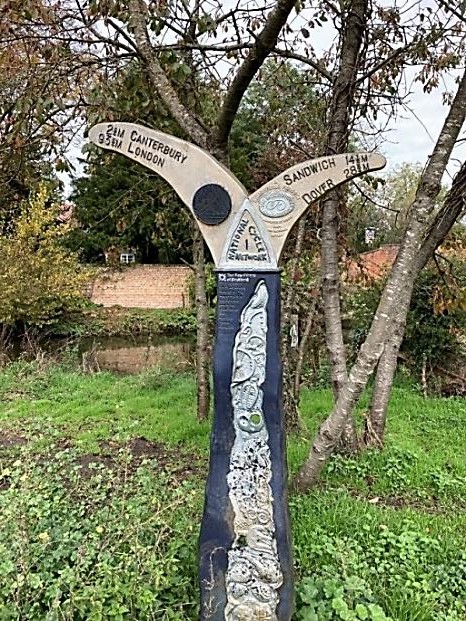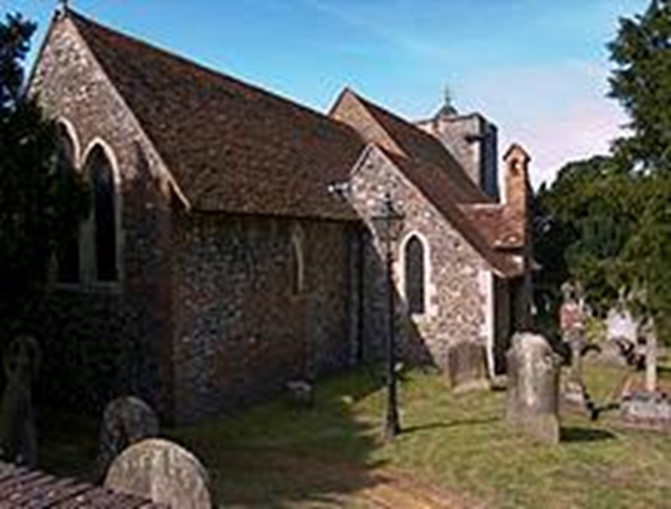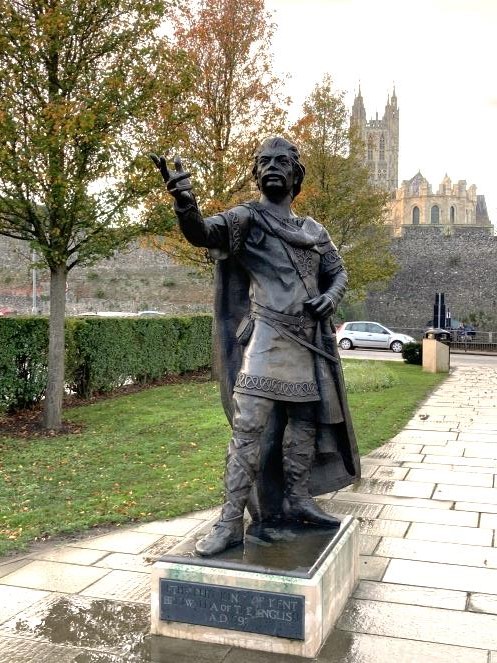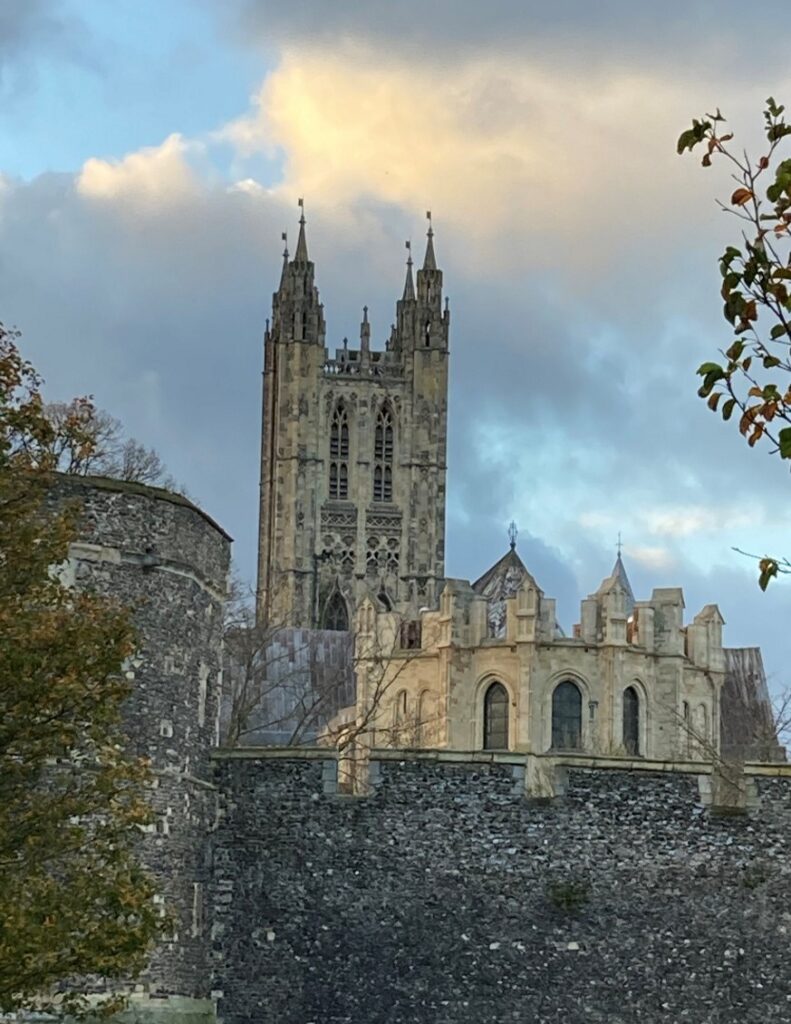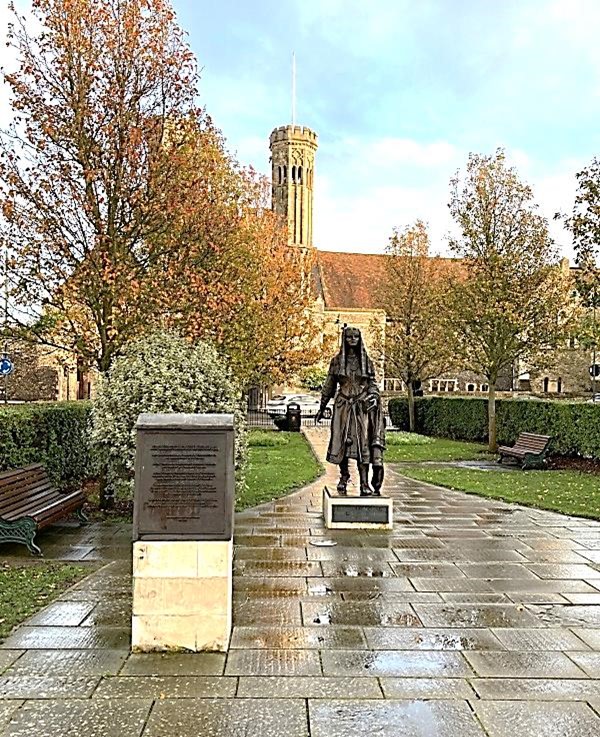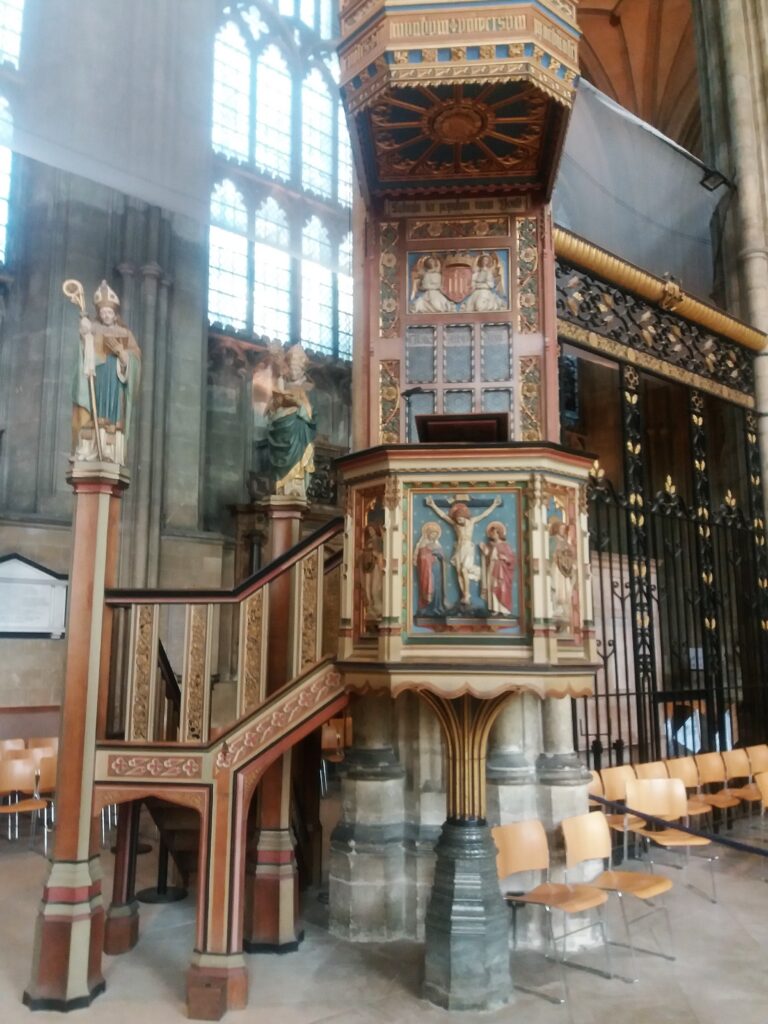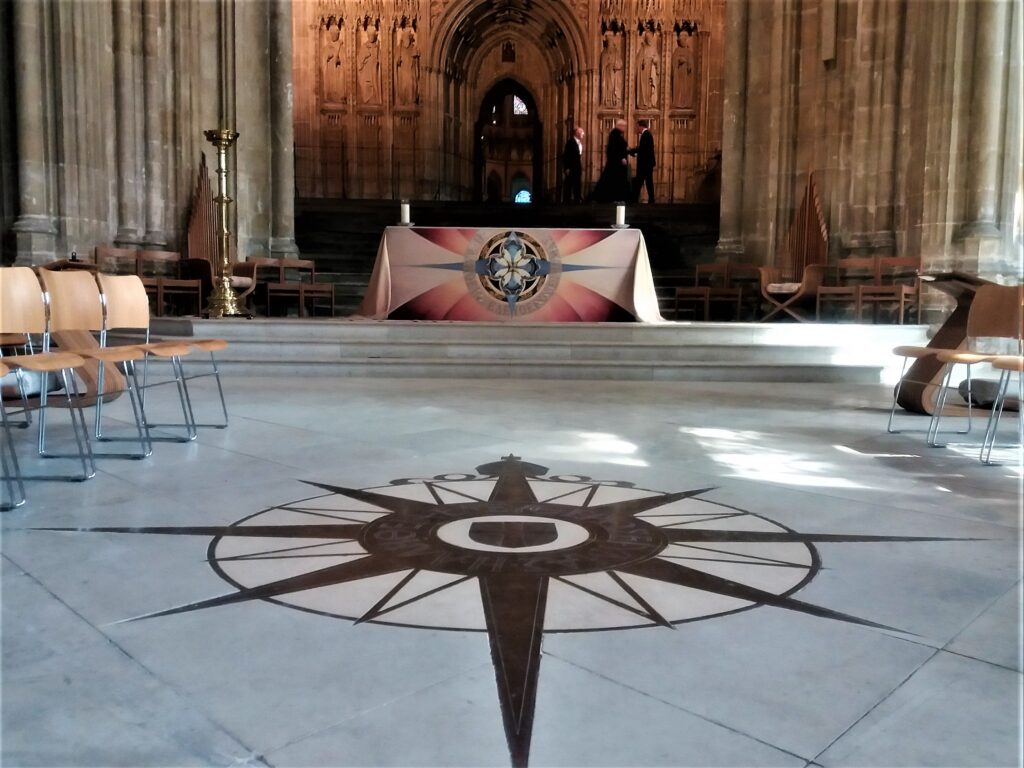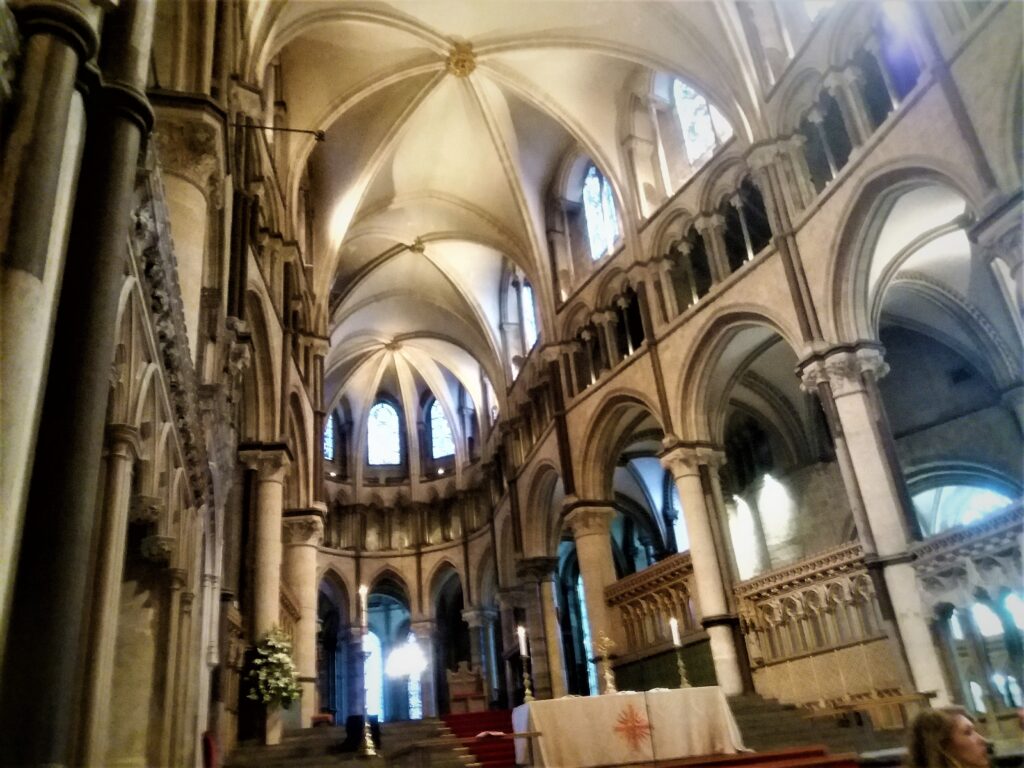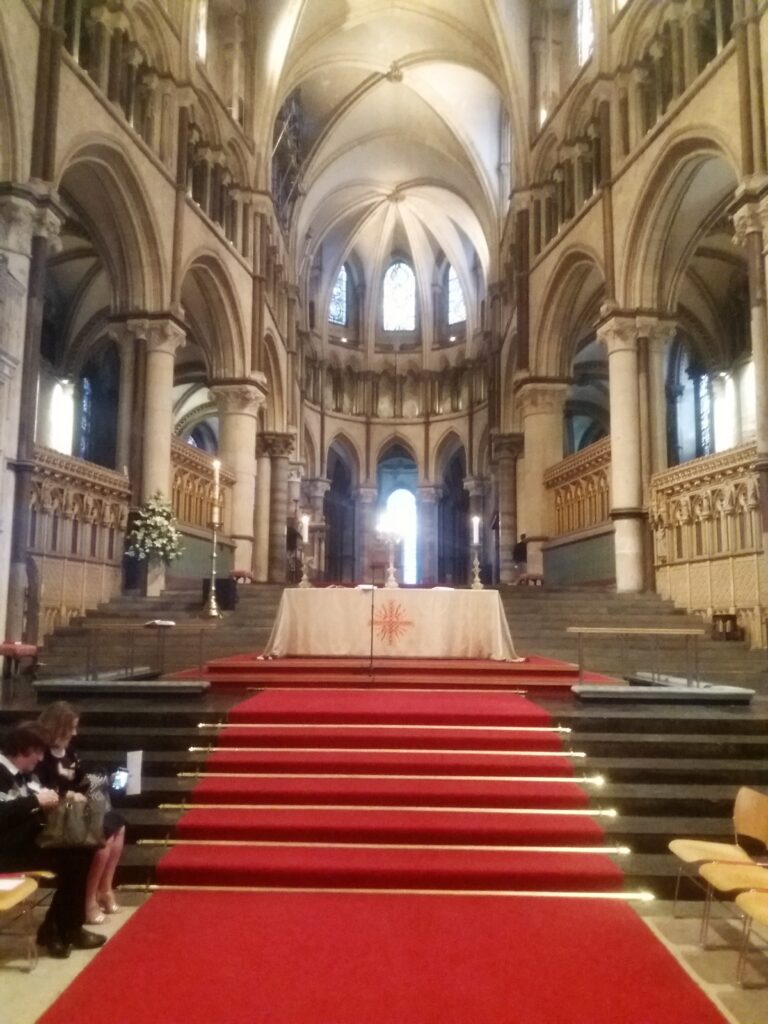By Priscilla White, Confraternity of St. James, UK and Camino Aficionada
Introduction | Historical Background

A bit of background history: Pope Gregory the Great (590-604) wished to convert the heathen tribes of Northern Europe to Christianity and despatched St Augustine to carry out his mission. Augustine set off for England but was so worried about the fierce reputation of the English that he and his forty monks begged to return to Rome. However, the Pope was determined that Augustine should persevere and in AD597 he landed at Ebbsfleet (near Ramsgate) on the Isle of Thanet to begin his ministry.
He was aided by Queen Bertha, a Frankish princess who was already a Christian, and she persuaded her husband King Ethelbert of Kent to meet Augustine. This meeting took place in the open air as the king was fearful about the possibility of witchcraft. Fortunately, Augustine made such a good impression on the Kentish king that he gave him the old Roman church of St Martin, named after the saint of Tours where Bertha originated from and where she worshipped. This is the oldest continually-used church in the English-speaking world.
The great abbey of St Augustine was built on land between St Martin’s and the city walls and until the Reformation would have rivalled the Cathedral in size and importance. Little of it now remains, apart from the stone walls, following the destruction of the monasteries in 16C.
Objective
One of the reasons for following St Augustine’s Way, apart from its historical and spiritual significance, is that in order to gain a Compostela when walking the Camino Inglés, (which I hope to do in the spring of 2021 unless prevented by Covid-19 restrictions) you need to walk at least 20kms in your home country. St Augustine’s Way is some 30kms from Ramsgate to Canterbury so well fits the bill, and where better to arrive than at Canterbury Cathedral, where Augustine became its first Archbishop?
From Ramsgate to West Stourmouth
Here is the starting point of the Way. This picture shows the corner of Pugin’s house, The Grange, where he lived with his family next door to the Chapel he designed and built in the mid-19C in the Gothic style. It is in this house where he designed the present House of Lords after the medieval Palace of Westminster burnt down in October 1834.
(You can get a stamp for your credential from the Pugin Centre before you set off along St Augustine’s Way.)
Setting forth on a windy October day with mask in place and endless layers to keep out the cold and rain. As you leave the town of Ramsgate behind, you walk along the cliff top down and round to Pegwell Bay with magnificent views over the Channel.
The shore is an important bird sanctuary with scores of wading birds poking about in the mudflats – redshank, shelduck, oyster catchers, a little egret and a lone curlew. Seals bask on the strip of land in the distance. A man is digging for lugworms way out on the flats with a wooden contraption to stop him sinking into the mud. As you pass through Pegwell village with its two adjacent pubs, one of them, the Belle Vue Tavern, boasts of a long history of smugglers with their contraband hidden in nearby caves. It reminds me of Kipling’s A Smuggler’s Song – “Brandy for the Parson, ‘Baccy for the Clerk”.
The cliff path follows the contours of the bay until you reach the village of Cliffsend. Perched above the cliff is a replica Viking ship, “The Hugin”. It is a reconstructed longship that sailed from Denmark to Thanet in 1949 as a gift from the Danish government to commemorate the 1500th anniversary of the arrival of Hengist and Horsa, leaders of the Anglo-Saxon invasion, at nearby Ebbsfleet. (King Ethelbert was a descendent of Hengist)
Leaving the village, you turn inland and shortly reach St Augustine’s Cross set by the side of the road near a golf course. An undistinguished setting for such an important moment in history.
St Augustine’s Cross was commissioned by the Earl of Granville in 1884 at that time Lord Warden of the Cinque Ports. He was inspired to erect it after a massive oak, known as the Augustine Oak was felled in a storm; according to legend it was under this tree that Augustine converted King Ethelbert and baptised him in a nearby stream (Stour) that was afterwards known as St Augustine’s Well. Tradition holds that the baptism was carried out on Whit Sunday AD597. The cross is carved in the early Christian style, modelled on 8C stone crosses at Sandbach in Cheshire. It stands quietly by the side of the road with farmland stretching out behind it.
Following along the river for a mile or so, you cross over the railway line and walk through fields along a footpath until you reach the village of Minster and Minster Abbey, founded by Domneva of Kent in AD670. She was succeeded by her daughter Mildred, a much loved prioress who became the patron saint of Thanet (Feast Day 13 July). The Abbey was largely destroyed in the 16C during Henry VIII’s Reformation. St Mildred’s Priory, adjacent to the abbey is now owned and run by Benedictine nuns who escaped from Germany in the war and set up their convent here in Minster. You can visit the Abbey in the afternoon and services are held there on a Sunday. (This is of course in normal Covid-free times. At the moment, it is closed to all visitors).
Just down the road from the Abbey stands the church of St Mary the Virgin, with the original building dating from AD670. Rebuilt by the Saxons and enlarged by the Normans, the present building dates from 1150 and the nave remains in its present form since that date. You can see St Augustine’s stone that he is said to have used when he preached. Traditionally called the “Cathedral of the Marshes”, it is a beautiful church with a great sense of peace and tranquillity set in village once on the edge of the Wantsum Channel. A lovely spot to sit and reflect awhile (and get a stamp for your credential)
Having stamped my credential and offered me a cup of coffee, I was joined for a stretch of the way by the Rev. Richard Braddy, vicar of St Mary’s who filled me in on the local history and showed me the path down to the River Stour. The hedgerows are full of berries, both hips and haws and dark purple sloes. A kestrel hovers overhead and pair of swans with their signets glide by along the stream at the side of the path. Up to the right at the edge of the field is the Abbots Wall, a mediaeval earthwork to stop the water from flooding into Minster during heavy rain. In St Augustine’s day, the land would have been under water so he would have sailed towards Canterbury across the Wantsum Channel.
The path follows the river and ahead of me on a stubby bush sits a stonechat with his mate; they flitter ahead of me as I approach them. Cormorants are drying their wings on a large tree by the river and a solitary marsh harrier quarters the ground looking for small prey. Richard leaves me to return home and I continue on to the hamlet of Pluck’s Gutter, apparently named after a Dutch drainage engineer called Ploeg, which is Dutch for plough. The Dutch were renowned for draining the marshes by digging ditches to create farmland. The rain sets in just as I arrive at the Dog and Duck pub and as my boots are muddy and my jacket is dripping, I eat my packed lunch outside on a bench outside the pub. The friendly waitress braves the rain to bring me a drink and stamp my credential. I could see spire of the church at Stourmouth ahead of me as I walked by the side of the river in the afternoon. The path was muddy after all the rain but the walking is easy underfoot and I made good time.
I soon reached the small village of West Stourmouth with its ancient and beautiful Anglo-Saxon church of All Saints It is no longer in use as a place of worship but open to visitors and is worth a visit to look at the beautiful stained glass windows. The sun came out at this point so I sat on the bench to enjoy a few minutes sunning myself.
Stained glass window showing saints Philip and Thomas. You can book a night in the church for the experience of “champing”.
From Stourmouth to Canterbury
From West Stourmouth, you continue along a well-trodden path by the river bank until you reach Grove Ferry, so called because it was used to ferry traffic across the Great Stour. The Grove Ferry Inn is a converted manor house set by the river and looking over Stodmarsh. In earlier times it held the rights to the ferry crossing and farmed 17 acres of lavender, creating a popular day trip destination, as there was a railway station nearby.
You can’t get a stamp but you can spend the night and it is a good place to end the first part of your journey. I ended my first day’s journey here and took the bus back home.
Retracing my bus journey of yesterday, I returned to Grove Ferry to complete the walk to Canterbury. The river Stour meanders calmly along the edge of Stodmarsh, once farmed by the monks of St Augustine’s Abbey in the Middle Ages and now home to rare birds and butterflies.
For this second day of my journey, I was joined by a fellow CSJ member, Dominic Kempson, who lives nearby. The weather was warm and sunny and made for a pleasant day’s walking along the banks of the river. Small boats chug up and down the river taking advantage of the good weather.
A herd of belted Galloway cattle were grazing in the distance and they help to keep the pastures cropped in this wild life haven.
Autumn berries glowing bright red in the sunshine along the path through Stodmarsh. This is a particularly beautiful part of the Way to Canterbury and you feel you are walking through history as you follow the old paths towards the village of Stodmarsh.
Leaving the marsh, you walk through a car park used by walkers and bird watchers, and up a track to the hamlet of Stodmarsh with its small flint stone church of St Mary’s originally built in the 12C. The church was open as the verger was doing the flowers for the altar. Although the church doesn’t have a stamp, the verger kindly signed and dated my credential.
These strange looking crossbeams support the bell turret and are believed to be unique in Kent.
Ahead is The Red Lion, a 15C pub where you can eat a meal and spend the night. A good place to stay if you are bird watching on the marsh, or another place to break your journey to Canterbury.
As we climbed the hill out of Stodmarsh along a quiet country lane surrounded by fields with the river flowing gently below us, we came across these tempting apples but reluctantly left them in the box as there was insufficient room in our knapsacks.
We continued on to the top of the hill and climbed over a stile into a muddy field. The path was unclear at this point and once we had left the field we found ourselves walking down the winding road to Fordwich, somehow missing the footpath that leads through the woods to the town. No harm was done, but a path through the autumn woodland would have been preferable to the road.
The town of Fordwich boasts as being the smallest in Britain. We stopped to eat our lunch on the bench in the churchyard of St Mary the Virgin. Unfortunately, the church was closed and a young woman dressed in black is expressing her annoyance as she finds the porch door locked. Shakespeare’s plays were performed in the Town Hall here during his lifetime and the actors used the upper room of the mediaeval hall unchanged to this day.
Autumn colours by the river Stour, and before the bridge was built, this is where the river was forded, hence the name of the town. We crossed the bridge and turned left to follow the river into Canterbury. A wooden fingerpost directs you along the path through water meadows and woodland until you reach the outskirts of Canterbury, passing by the church of St Martin’s, used by St Augustine, with the agreement of King Ethelbert, when he arrived in Canterbury to begin his mission.
Canterbury
As you pass by the Abbey, you come across the statue of Queen Bertha walking down Lady Wootton’s garden. Her husband is beckoning her to join him after she has attended Mass at St Martin’s.
This is a particularly beautiful view of the Cathedral standing high above the city walls with the Caen stone glowing in the late afternoon light as you cross over the road and walk down Burgate to the main entrance.
The Cathedral precincts are closed at the moment and the front of the building is covered in scaffolding whilst restoration works are carried out.
There was a long queue of visitors waiting to enter via a side entrance. My credential was stamped and we were welcomed into the Cathedral. I had completed the 20kms required for my Compostela.
Arriving at the Cathedral, credential in hand with my fellow pilgrim, Dominic Kempson.
The site of St Thomas Becket’s martyrdom with the arresting sculpture by Giles Blomfeld above the altar stone representing the knights’ four swords; two swords and two shadows.
We sat for a while in the main body of the cathedral, contemplating the journey from Ramsgate to Canterbury and feeling very much part of the history of earlier times with past centuries seeming very present as we followed in St Augustine’s footsteps.
October, 2020
